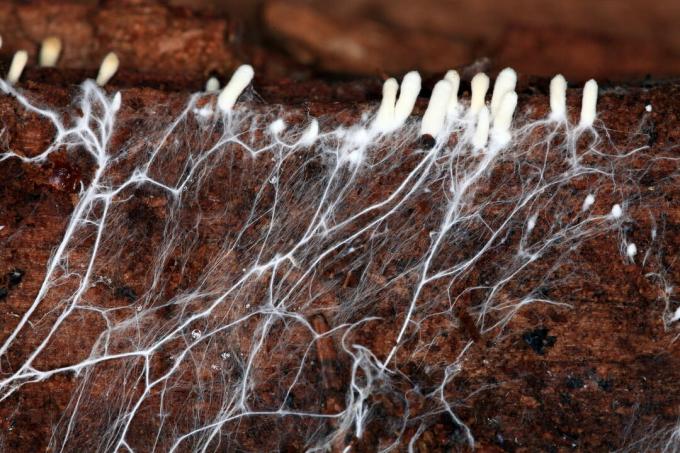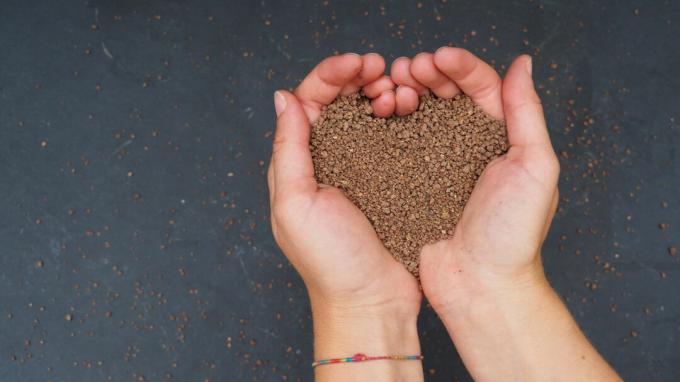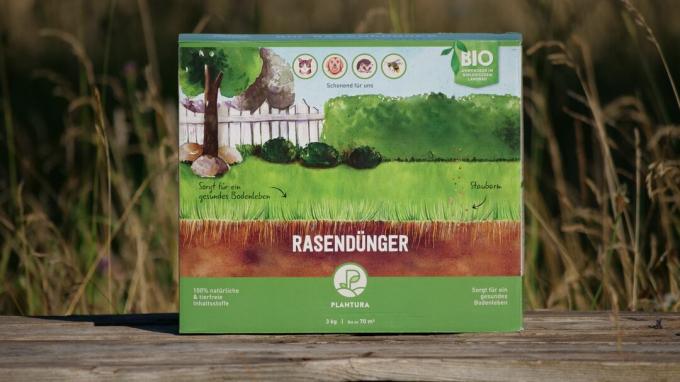Organic fertilization benefits people, animals and nature. We show why you should treat your lawn with organic lawn fertilizer and what advantages it has.

The use of organic fertilizers represents a kind of fertilizer revolution: It has long been known that purely mineral fertilizers lead to a deterioration in soil quality. In addition, in the absence of healthy soil life, a not insignificant part of the nutrients settles without plants being able to absorb them. Meanwhile, with the approaching end of phosphate resources and climate change in sight, the energy-intensive processes for the production of artificial fertilizers are viewed more and more critically. Organic fertilizers are intended to counteract artificial fertilizers and restore the natural health of soil and plants. Organic fertilizers are now also available as organic lawn fertilizers.
contents
-
Organic lawn fertilizer: components and properties
- Components of organic lawn fertilizers
- Properties of organic lawn fertilizers
- Organic Lawn Fertilizer: Effect and Benefits
-
Application of organic lawn fertilizer
- Organic lawn fertilizer in spring and summer
- Organic autumn lawn fertilizer
Organic lawn fertilizers use materials that are "bio-effective", meaning they interact with and affect the biological phase of the soil. In contrast to mineral lawn fertilizers, the soil organisms - fungi, bacteria, insects, algae and all kinds of other things - should not be avoided, but rather used. In the following you will learn everything about the components, properties, effects and use of organic lawn fertilizers.
Organic lawn fertilizer: components and properties
Here you can find out which special components make up organic lawn fertilizer and how they affect the properties of the fertiliser.
Components of organic lawn fertilizers
Organic raw materials form the basis for an organic lawn fertilizer. In the spirit of economic cycles, they are primarily made from waste from the food, beverage and animal feed industries. Leftovers of plant and animal origin can be processed in them, examples are peels, vinasses, oil cake, horn and blood meal or animal excrement. The leftovers contain plant nutrients encased in natural, organic packaging. However, this organic layer is not just ballast: its presence promotes healthy soil life and the formation of humus. Even living organisms or perennial forms of them can be included in organic lawn fertilizers. Bacterial or fungal strains that have a positive impact on lawn root growth or nutrient availability are not uncommon. But organic lawn fertilizers do not have to be of purely organic origin. Some mineral substances that can also be used in organic farming can also be used to optimize their effect.

Tip: The phosphate content of organic fertilizers is often lower than that of conventional fertilizers because there is sufficient phosphate in most soils. However, it is "fixed" in the form of calcium phosphates and is only sparingly soluble and therefore not available to plants. Organic fertilizers aim to enable the soil and soil life to recycle this phosphate, rather than simply adding more.
Properties of organic lawn fertilizers
The properties of organic lawn fertilizers can be derived from the ingredients:
| nutrient | - Nutrients contained can be used by the lawn and microfauna and microflora of the soil. The nutrient composition is of course tailored to the needs of the lawn - Trace elements are also present in the natural materials used - The high organic matter content means that nutrients are released in a delayed and slow-flowing manner. A natural long-term effect occurs. Because soil life is affected by environmental conditions, nutrients are only made available when the weather is growing - The nutrient conversion is pH-neutral: the acidity of the soil remains unaffected |
| soil properties | - The organic substance can – if present in sufficient quantities – be used to build up humus |
| soil life | - The organic material enables the survival of soil organisms as it serves as a sustainable source of energy - Microorganisms contained can enter into symbioses with the lawn roots and thus improve the absorption of water and nutrients. Other organisms, on the other hand, ensure that nutrients bound to soil particles are dissolved again, or change the pH value of the soil in a favorable way |
| environmental sustainability and animal welfare | - Since the materials contained are largely biological waste, their use is sustainable and environmentally friendly - The application has no potential for harm to wild and domestic animals or to humans |
Tip: A healthy soil should contain all the microorganisms needed to unlock nutrients from the soil. Symbiotic fungi are also widespread, and lawns can also form symbioses with specific mycorrhizae. However, the stock of soil life is constantly thinned out if the soil is not maintained, so that the colonization of new strains can have a positive effect.

If you know more about organic fertilizer in general, you will find it here.
Organic Lawn Fertilizer: Effect and Benefits
The concrete effect on the lawn is what interests most hobby gardeners the most. The properties of an organic lawn fertilizer do the following on your lawn:
- The lawn plants are evenly supplied with all the main nutrients and trace nutrients. Over-fertilization and deficiency symptoms as well as leaching are excluded with reasonably regular use.
- The long-term effect leads to constant growth, which prevents disease and strengthens the heat and drought tolerance of the lawn. Due to the weather-dependent implementation, nutrients are only released when the lawn can use them sensibly.
- By feeding soil life, it is able to participate in the development of nutrients and their uptake. As a result, the lawn is supplied more reliably and effectively. As a result, the amount of fertilizer required could even decrease in the long term.
- If humus is formed by using the organic fertilizer, it improves the water and nutrient storage capacity of the soil. A lawn is better prepared for dry phases and forgives if you forget to fertilize or if it is done too late.
- Humus also improves soil aeration and reduces soil resistance: the lawn can root deeper and take better care of itself. Excess water from heavy rainfall is drained away quickly and cannot damage the lawn roots. More about the properties of humus you can also read here.
- Since the pH value of the soil remains unaffected, there is no need for regular liming. more on the subject Lawn liming you'll find here.
- After fertilization, all living beings can enter the lawn again immediately, since no harmful or irritating substances have been distributed.
Compared to mineral lawn fertilizers, organic lawn fertilizers have many advantages. Although the latter provide nutrients for plants, they lead to negative effects in all other areas.
Application of organic lawn fertilizer
Organic lawn fertilizers can be used between February and October. Since, in addition to the nutrients, their important organic "shell" is also distributed, larger amounts are usually applied than if the same amount of nutrients were fertilized with minerals. Since the process of implementation in the soil takes some time, the effect begins gradually within a month and then lasts for a certain time depending on the composition. That's why you should ideally fertilize with foresight: For example, you should prepare the lawn for the energy-sapping spring shoots with fertilization between February and April. Because of the natural long-term effect, two to three fertilizations a year are sufficient - one or two between spring and summer and one between late summer and autumn. Spreading is best done with a spreader, although a slightly less even distribution will not cause any damage. You can also touch organic lawn fertilizer with your bare hands without hesitation if you distribute it by hand. After fertilization, the lawn can be stepped on again immediately by humans and animals.

Tip: If not otherwise possible, you could even apply the entire annual fertilization in the form of organic lawn fertilizer at a single date, since over-fertilization is impossible. However, it is more beneficial for the lawn to divide it into spring and autumn fertilization, because optimal winter preparation requires a different nutrient composition.
Summary: Application of organic lawn fertilizer
- The application takes place between February and October
- Depending on the weather, the effect begins within a month after application
- One or two fertilizations are done between spring and summer, one between late summer and autumn
- Manual application or the use of spreaders are equally possible
- After fertilization, the lawn can be used again immediately
More on how to make your Lawn optimally fertilized, you'll find here.
Organic lawn fertilizer in spring and summer
Organic lawn fertilizers that are designed for use in spring and summer have an increased nitrogen content. This is essential for vegetative growth: as the basis of DNA and chlorophyll, it enables the development of photosynthetically active cells. It is also a component of all plant proteins involved in the life processes of lawn plants.

Strong growth in spring ensures that there is sufficient energy available for branching and mowing. This makes the lawn as thick as a carpet and competitive with weeds. This is exactly the goal we have in developing ours Plantura organic lawn fertilizer tracked. This is applied as follows:
- When planting new seeds, 100 g/m² are distributed on the seedbed
- Additional fertilization after the second or third cut of a freshly laid lawn: 40 g/m²
- Maintenance fertilization between February and October: 80 to 120 g/m² per year in two or more doses
- For regeneration after scarifying: 70 g/m²
More to Lawn fertilization in spring can be found in our special article.
Organic autumn lawn fertilizer
Organic autumn lawn fertilizers are used to prepare the lawn for winter. This preparation requires an adjusted nutrient composition: the nitrogen content is lower, the potassium content higher than with a spring and summer fertilizer. Potassium ensures a high salt concentration in the vacuole of the plant cells and thus protects them from freezing - just like sea salt protects the sea from freezing. It also ensures the construction of stable cell walls. On the other hand, too much nitrogen supply in late summer or autumn would not be beneficial: growth stimulated by increased nitrogen supply is very susceptible to frost. A lawn that is supplied with the right nutrient composition stays green even in winter and even continues to grow slowly at temperatures of around 2 to 3 °C. In our Plantura Organic Autumn Lawn Fertilizer we have realized exactly this composition of nutrients. We recommend the following application rate: between July and October 50 to 80 g/m².
More to autumn lawn fertilization generally you can read in this article.
More info about lawn fertilizers can also be found here.

